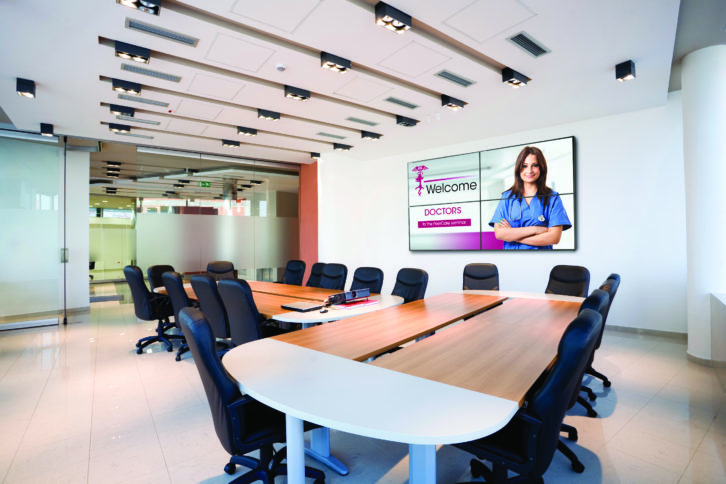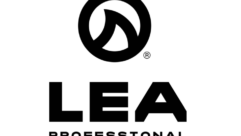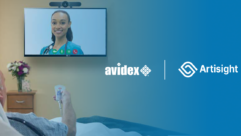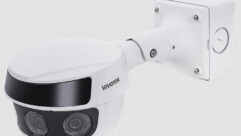

Hospitals are like little, self-contained cities. There’s traffic and pedestrians, shops, dining facilities, offices, and areas for people to congregate. There also is the need to communicate information inwardly, to the “city workers” (hospital staff), as well as outwardly, to patients and visitors.
Because of its ability to streamline these communications, digital signage offers hospitals a number of solutions for anything from wayfinding and patient tracking, to food services, and marketing and communications.
Image above: Oregon Health and Science University (OHSU) and its Doernbecher Children’s Hospital have been at the forefront of the treatment of cancer and other illnesses affecting children for decades. In July, Planar Systems provided LCD displays to OHSU’s Biomedical Research Building. These displays—Planar PS-Series—form part of what is called The Children’s Wall, an area that serves as a powerful visual reminder of children receiving care at Doernbecher, families who love and support them and researchers who are working hard to find cures for the illnesses they face.
“It’s kind of crazy how many different industries are within that same environment,” says Mike Strand, president and CEO of StrandVision, a digital signage provider. “And obviously [depending on to whom you are communicating], there’s a different set of messages.”
Ryan Cahoy, managing director at Rise Display, a digital signage display, content management provider, and integrator in Shawnee, Kan., notes that one area where he is seeing a lot of activity is in donor relations—specifically with donor boards that provide biographical information about those who have contributed funds and resources to the hospital. “The foundations at these hospitals have really big targets to raise money to build new facilities and to get new equipment, and they have a lot of really prestigious donors,” he says. “They’re looking for ways not only to thank those donors—to tell their stories—but also to communicate where that money is going.” These days, this can be achieved with video.
One of the biggest issues with hospital deployments is who is driving them. Sometimes it’s the IT department, sometimes it’s the facilities management division, and sometimes it’s marketing and communications. The problem is that in many cases, these departments don’t communicate with each other, and when they do, they often have different and sometimes opposing goals. “Everybody is always saying, ‘How can we keep IT out of this?’” Cahoy says. “From a reseller and integrator perspective, as tempting as it is to grab that sale real quick and say, ‘Let’s be quiet and do this,’ you really cause a lot of heartache down the road for everybody involved, because unfortunately, these devices sit on the network and that’s a really important part of it, and you don’t want to offend somebody who can make your life really, really difficult.” And IT must be diligent, if only to comply with strict HIPAA regulations. “It’s just part of the process that you have to go through, and unfortunately, it does take time.”

But taking the time to involve the right parties builds the foundation for more opportunities in the future, notes Brian McClimans, managing director of business development at Peerless Industries, which offers healthcare-specific solutions through its PeerCare line of products. “Once you’ve done that, then you have the backbone to put in other channels and other locations,” he says. “If you think about it, what marketing wants is to get a message out there and have it look good. And IT wants it to work.” The trick is to break through the barriers between them to get everyone on the same page.
Sean Matthews, president of Visix, a digital signage software developer, notes that digital signage offers hospitals a way to brand themselves as current and modern—an important goal since, as is the case in any industry, there is competition among them. “There are a lot of rollups in the U.S. healthcare market with hospital groups acquiring lots of different hospitals, and in essence they’re competing with other hospitals,” he says. Not only do they want to convey that they are on the cutting edge of healthcare; they need to communicate that they’re on the cutting edge, period.
However, Matthews argues, oftentimes the content that is displayed on these systems— particularly when it comes to outward-facing, visitor communications—is mediocre at best. “The problem is, what they really want to convey is not clearly defined. No one has taken the initiative to say, ‘Hey, we want to increase donations through our blood drive. We want to increase awareness about poverty in our community and what you can do to help. We want to increase awareness about our fitness programs for the elderly,’” he says. Many facilities may be enthusiastic about integrating this technology, but they aren’t necessarily using it well.
For Matthews, this provides AV integrators with an opportunity to get involved in creative services, either by establishing their own internal creative services departments, or through partnering with other firms that are already offering them. He likens this concept to that which has been applied for years—programming for the graphical user interfaces (GUI) for Crestron and AMX control panels. “A lot of [AV integrators] have either outsourced the UIs for those systems because there is a whole cottage industry of people that do that, or they have hired people to do it,” he says. “They’re already quasi-creative and they’re already providing this service.”
BREAKING IN
Understandably so, hospitals are risk-averse, making it difficult for AV integrators who have not previously worked in this space to get their foot in the door. Jennifer Davis, vice president of marketing at Planar Systems, advises AV firms in this situation to start by targeting projects in smaller medical facilities, such as doctors’ and dentists’ offices. “These are great ways to build up healthcare expertise to leverage to larger projects, while getting to know the nuances and needs of the space,” she says. She adds that when targeting hospitals outright, again start small: “For instance, talk to the development office about the benefits of a digital donor recognition wall, with dynamic content reflecting the latest gifts, and the ability to promote an upcoming capital campaign. The same conversations that you have with the hospital can also be leveraged to other donor-sponsored non-profits—museums and higher education—for additional new business development.”—Carolyn Heinze










